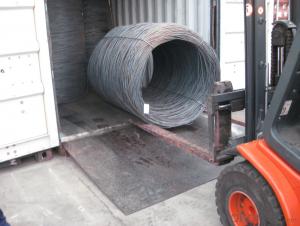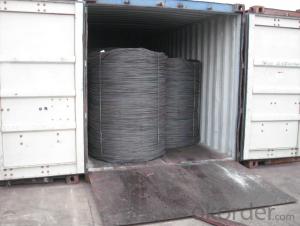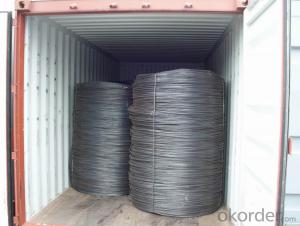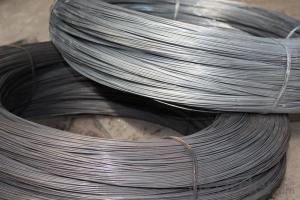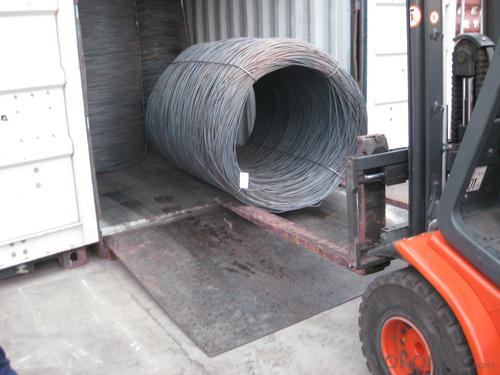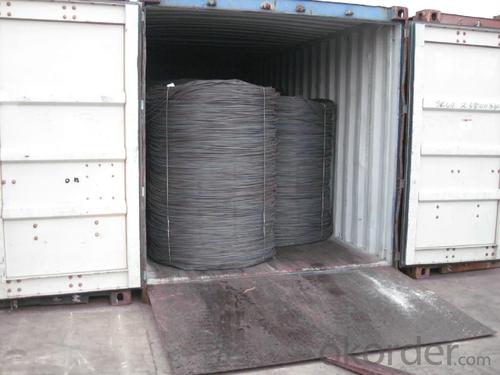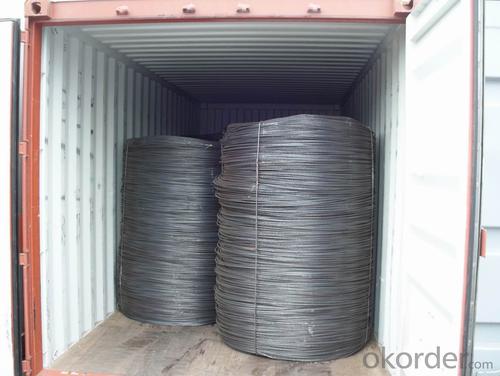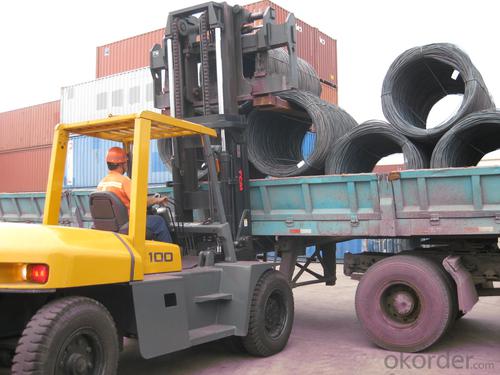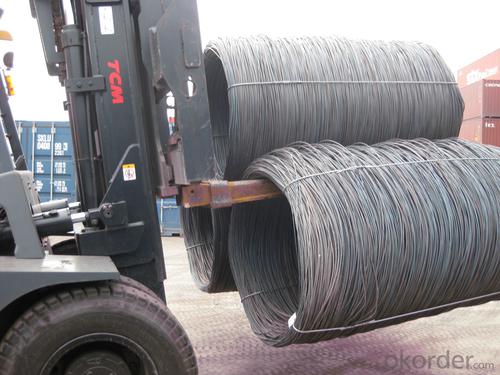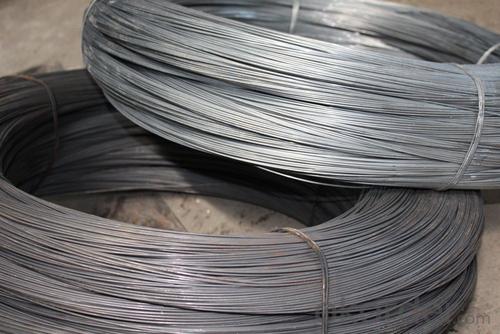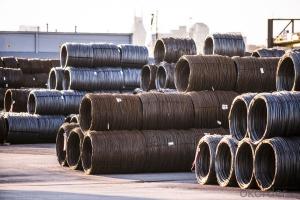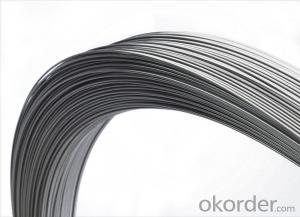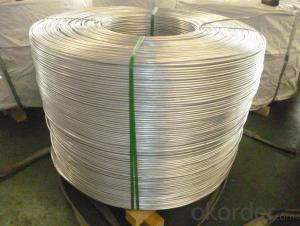SAE1006Cr Carbon Steel Wire Rod 11mm for Welding
- Loading Port:
- Shanghai
- Payment Terms:
- TT OR LC
- Min Order Qty:
- 100 m.t
- Supply Capability:
- 30000 m.t/month
OKorder Service Pledge
OKorder Financial Service
You Might Also Like
Specification
Description of SAE1006Cr Carbon Steel Wire Rod 11mm for Welding:
OKorder is offering Color Coated Steel Coil Prepainted Steel Coil at great prices with worldwide shipping. Our supplier is a world-class manufacturer of steel, with our products utilized the world over. OKorder annually supplies products to European, North American and Asian markets. We provide quotations within 24 hours of receiving an inquiry and guarantee competitive prices.
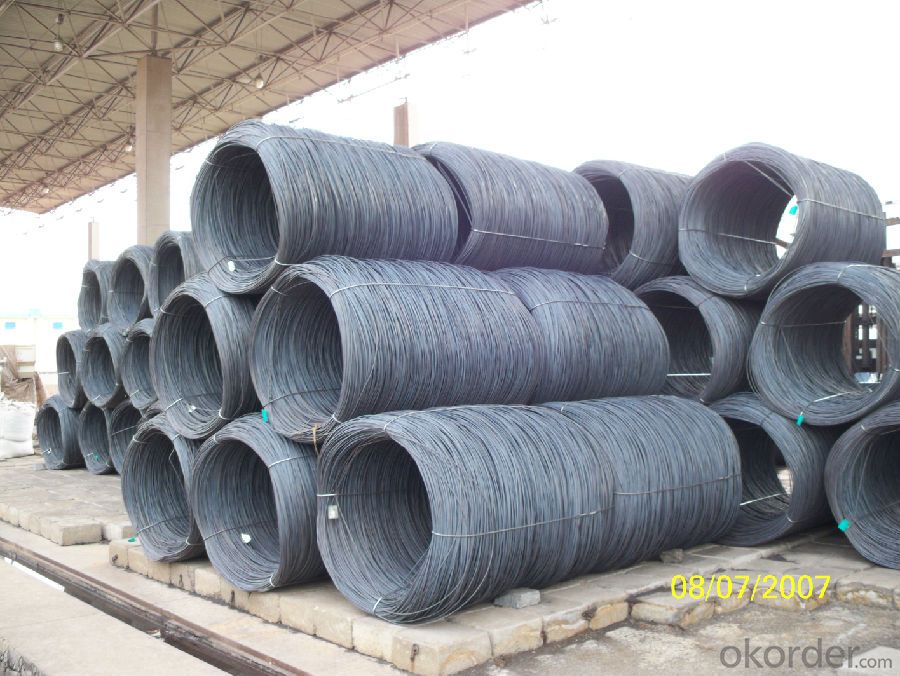
Applications of SAE1006Cr Carbon Steel Wire Rod 11mm for Welding:
Color Coated Steel Coil Prepainted Steel Coil are ideal for structural applications and are widely used in the construction of buildings and bridges, and the manufacturing, petrochemical, and transportation industries.
Main Product Features of SAE1006Cr Carbon Steel Wire Rod 11mm for Welding:
· Premium quality
· Prompt delivery & seaworthy packing (30 days after receiving deposit)
· Corrosion resistance
· Can be recycled and reused
· Mill test certification
· Professional Service
· Competitive pricing
Specifications of SAE1006Cr Carbon Steel Wire Rod 11mm for Welding:
PPGI:
1, Introduction: Color coated steel coils(sheets), i. E. PPGI, also called prepainted steel coils(sheets), are made of galvanized steel coils(sheets) with polymer coatings as surface. It's a new enclosure material and building board with characteristics of light-weighted, heat preserved&insulated, easily installed with bright colors.
2, Production Process: Pretreatment(Degreasing)_Drying_Chromating_Paint Basic Oil_Cooling_Drying_Color Coating_Cooling_Film-covering_Rolling Up
3, Characteristics:
Good at corrosion resistence. Besides zinc coating of the basic plate of galvanized steel sheet, the color coating as the surface has double lifetime to ensure better anticorrosion effect.
With excellent cold bending molded manufacturablity, PPGI products can be processed or directly used as final product. As being light-weighted and conveniently transported, they're widly used to replace wood to save energy.
4.There're thousands of colors can be chosen as per different application. Any color plays well in decoration.
No pollution with high recycling rate, PPGI coils and sheets are strongly recommended as enviroment-friendly products by the government.
5, eye bands and 4 circumferential bands in steel, galvanized metal fluted rings on inner and outer edges, galvanized.
| commodity | SAE1006Cr Carbon Steel Wire Rod 11mm for Welding |
| Techinical Standard: | JIS G3302-1998, EN10142/10137, ASTM A755 |
| grade | Q195,Q215,Q235,SAE1006,SAE1008 SAE1006Cr |
| Types: | Mesh welding |
| Base metal | galvanized, galvalume, cold rolled steel |
| Thickness | 0.14-1.0mm(0.16-0.8mm is the most advantage thickness) |
| Width | 610/724/820/914/1000/1200/1219/1220/1250mm |
| Type of coating: | PE, SMP, PVDF |
| Zinc coating | Z60-150g/m2 or AZ40-100g/m2 |
| Top painting: | 5 mic. Primer + 15 mc. R. M. P. |
| Back painting: | 5-7 mic. EP |
| Color: | According to RAL standard |
| ID coil | 508mm610mm |
| Coil weight: | 2--3MT |
| Package: | Properly packed for ocean freight exportation in 20'containers |
| Application: | Industrial panels, roofing and siding for painting/automobile |
| Price terms | FOB, CFR, CIF |
| Payment terms | 20%TT in advance+80% TT or irrevocable 80%L/C at sight |
| delivery time | 25 days after recepit of 20% TT |
| Remarks | Insurance is all risks |
| MTC 3.1 will be handed on with shipping documents | |
| We accept SGS certificatation test |
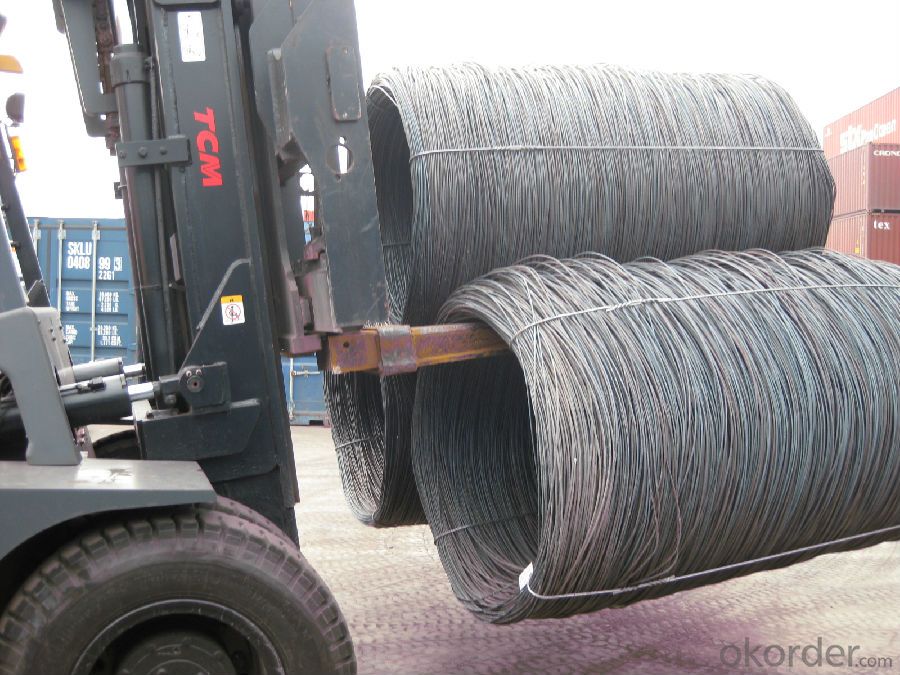
FAQ of SAE1006Cr Carbon Steel Wire Rod 11mm for Welding:
Q1: Why buy Materials & Equipment from OKorder.com?
A1: All products offered byOKorder.com are carefully selected from China's most reliable manufacturing enterprises. Through its ISO certifications, OKorder.com adheres to the highest standards and a commitment to supply chain safety and customer satisfaction.
Q2: How do we guarantee the quality of our products?
A2: We have established an advanced quality management system which conducts strict quality tests at every step, from raw materials to the final product. At the same time, we provide extensive follow-up service assurances as required.
Q3: How soon can we receive the product after purchase?
A3: Within three days of placing an order, we will begin production. The specific shipping date is dependent upon international and government factors, but is typically 7 to 10 workdays.
Q4: What makes stainless steel stainless?
A4: Stainless steel must contain at least 10.5 % chromium. It is this element that reacts with the oxygen in the air to form a complex chrome-oxide surface layer that is invisible but strong enough to prevent further oxygen from "staining" (rusting) the surface. Higher levels of chromium and the addition of other alloying elements such as nickel and molybdenum enhance this surface layer and improve the corrosion resistance of the stainless material.
Q5: Can stainless steel rust?
A5: Stainless does not "rust" as you think of regular steel rusting with a red oxide on the surface that flakes off. If you see red rust it is probably due to some iron particles that have contaminated the surface of the stainless steel and it is these iron particles that are rusting. Look at the source of the rusting and see if you can remove it from the surface.
- Q: What are the common production processes for francium-coated steel wire rod?
- The common production processes for francium-coated steel wire rod may include cleaning and pre-treatment of the steel rod, application of a francium coating through methods like electroplating or chemical vapor deposition, drying or curing of the coating, and quality control checks before packaging and distribution.
- Q: What are the common applications of alloy steel wire rod?
- Alloy steel wire rod has a wide range of applications due to its unique properties and characteristics. Some of the common applications of alloy steel wire rod include: 1. Automotive industry: Alloy steel wire rods are extensively used in the automotive industry for the production of various components such as springs, suspension systems, wheel rims, and engine parts. The high strength and durability of alloy steel wire rod make it suitable for withstanding the demanding conditions and loads experienced by these components. 2. Construction industry: Alloy steel wire rods are also widely used in the construction industry. They are utilized in the manufacturing of reinforcing bars (rebars) which are essential for reinforcing concrete structures such as bridges, buildings, and highways. The high tensile strength and corrosion resistance of alloy steel wire rod ensure the longevity and structural integrity of these constructions. 3. Manufacturing industry: Alloy steel wire rods find applications in various manufacturing processes such as welding, machining, and fabrication. They are commonly used in the production of fasteners, wire mesh, wire ropes, and springs. The unique properties of alloy steel, such as high tensile strength, good formability, and resistance to wear and fatigue, make it an ideal choice for these applications. 4. Aerospace industry: Alloy steel wire rods are employed in the aerospace industry for the production of components and parts that require high strength, excellent fatigue resistance, and resistance to extreme temperatures. These include aircraft landing gear, engine components, and structural parts. The superior mechanical properties of alloy steel wire rod make it suitable for withstanding the demanding conditions encountered in aerospace applications. 5. Energy industry: Alloy steel wire rods are used in the energy industry for various applications. They are utilized in the manufacturing of power transmission cables, electrical conductors, and wire mesh screens. The high electrical conductivity and corrosion resistance of alloy steel wire rod make it an ideal choice for these energy-related applications. In summary, alloy steel wire rod is commonly used in the automotive, construction, manufacturing, aerospace, and energy industries due to its high strength, durability, formability, and resistance to wear, corrosion, and fatigue. Its versatility and unique properties make it an essential material for a wide range of applications.
- Q: How is steel wire rod used in the production of reinforcing bars?
- Steel wire rod is used in the production of reinforcing bars by being heated and stretched to the desired diameter and length. It is then coiled and cut into specific lengths to be used as reinforcement in concrete structures. The reinforcing bars provide additional strength and support to the concrete, improving its load-bearing capacity and durability.
- Q: What are the standard lengths available for steel wire rod?
- Steel wire rods are available in a variety of standard lengths, which are typically measured in feet or meters. The most common standard lengths for steel wire rods range from 6 to 12 meters (20 to 40 feet). However, it is important to note that the specific standard lengths of steel wire rods can vary depending on the manufacturer and the intended application. Additionally, custom lengths can often be requested and produced to meet specific project requirements.
- Q: What are the common applications of low alloy steel wire rod?
- Low alloy steel wire rod has various common applications due to its specific properties and characteristics. Some of the most common applications of low alloy steel wire rod include: 1. Construction industry: Low alloy steel wire rod is widely used in the construction industry for reinforcing concrete structures. It is commonly used to manufacture welded wire mesh, which is used to reinforce concrete slabs, walls, and foundations. The high strength and durability of low alloy steel wire rod make it an ideal choice for withstanding heavy loads and preventing structural failure. 2. Automotive industry: Low alloy steel wire rod is extensively used in the automotive industry for manufacturing various components. It is commonly used to produce springs, suspension systems, and other high-stress components that require excellent strength and fatigue resistance. The low alloy steel wire rod's ability to withstand heavy loads and constant stress makes it well-suited for automotive applications. 3. Manufacturing industry: Low alloy steel wire rod is also used in various manufacturing processes. It is commonly employed in the production of fasteners, such as screws, bolts, and nuts, due to its high tensile strength. Additionally, low alloy steel wire rod is used for manufacturing wire ropes, cables, and other high-strength wire products that require durability and resistance to corrosion. 4. Engineering industry: Low alloy steel wire rod finds applications in the engineering industry for fabricating structural components, machinery parts, and equipment. It is often used for manufacturing gears, shafts, and bearings due to its excellent wear resistance and ability to withstand heavy loads. The low alloy steel wire rod's properties make it a reliable choice for critical engineering applications. 5. Electrical industry: Low alloy steel wire rod is used in the electrical industry for manufacturing various electrical conductors and components. It is commonly used to produce overhead power lines, electrical cables, and wires due to its high electrical conductivity and mechanical strength. The low alloy steel wire rod's ability to carry electricity efficiently and its resistance to mechanical stress make it suitable for electrical applications. In summary, low alloy steel wire rod has a wide range of applications in the construction, automotive, manufacturing, engineering, and electrical industries. Its high strength, durability, wear resistance, and electrical conductivity make it a versatile material for various applications that require reliability and performance.
- Q: What are the common safety guidelines for steel wire rod usage?
- Some common safety guidelines for steel wire rod usage include wearing appropriate personal protective equipment such as gloves, safety glasses, and steel-toed shoes. It is important to handle and store the wire rods properly to prevent injuries, such as avoiding sharp edges and ensuring that they are stacked securely. Regular maintenance and inspection of equipment and tools used with steel wire rods should also be conducted to ensure their safe operation. Additionally, proper training and awareness of potential hazards associated with handling steel wire rods are crucial for maintaining a safe working environment.
- Q: What are the main factors influencing the choice of steel wire rod manufacturer?
- There are several main factors that influence the choice of a steel wire rod manufacturer. These factors include: 1. Quality of the product: One of the primary factors influencing the choice of a steel wire rod manufacturer is the quality of the product they offer. Customers look for manufacturers that produce high-quality steel wire rods that meet their specific requirements and standards. This includes factors such as the strength, durability, and consistency of the wire rod. 2. Price: Price is another crucial factor that influences the choice of a steel wire rod manufacturer. Customers compare prices offered by different manufacturers and choose the one that provides the best value for money. However, it is important to consider the price in relation to the quality of the product and the overall service provided by the manufacturer. 3. Reliability and reputation: The reliability and reputation of a steel wire rod manufacturer play a significant role in the decision-making process. Customers prefer manufacturers with a proven track record of delivering high-quality products consistently and on time. Positive customer reviews, testimonials, and references from other trusted sources can greatly influence the choice of a manufacturer. 4. Production capacity and capabilities: The production capacity and capabilities of a steel wire rod manufacturer are important considerations for customers. Depending on their specific needs, customers may require a manufacturer that can produce large quantities of wire rods within a specified timeframe. Additionally, customers may also consider the manufacturer's ability to provide customized wire rod solutions or different variations of the product. 5. Technical expertise and support: Steel wire rod manufacturers with strong technical expertise and excellent customer support are often preferred by customers. Manufacturers that can provide technical guidance, assistance with product development, and after-sales support are seen as valuable partners in the steel wire rod purchasing process. 6. Environmental and sustainability practices: In recent years, environmental and sustainability practices have become increasingly important factors in the choice of a steel wire rod manufacturer. Customers look for manufacturers that prioritize sustainable production methods, minimize waste and emissions, and comply with environmental regulations. Overall, the main factors influencing the choice of a steel wire rod manufacturer are quality, price, reliability, production capacity, technical expertise, and environmental practices. Customers carefully evaluate these factors to ensure they select a manufacturer that can meet their specific requirements and provide a high-quality product and service.
- Q: What are the common production processes for berkelium-coated steel wire rod?
- The common production processes for berkelium-coated steel wire rod typically involve a series of steps. Firstly, the steel wire rod is cleaned and coated with a layer of berkelium using techniques like electroplating or physical vapor deposition. This helps to enhance the properties of the steel wire rod, such as corrosion resistance or conductivity. After the coating process, the wire rod is subjected to heat treatment to ensure proper adhesion and durability of the berkelium coating. Finally, the wire rod may undergo additional processes like cutting, shaping, or surface finishing to meet specific requirements before it is ready for use in various applications.
- Q: How is steel wire rod used in the manufacturing of cables?
- Steel wire rod is used in the manufacturing of cables as it serves as the core material for strength and support. The steel wire rod is typically drawn through a series of dies to reduce its diameter and increase its strength, resulting in a high-tensile wire. This wire is then twisted or braided together with other wires or fibers to form the cable's core, providing durability and stability.
- Q: What are the common production processes for lead-coated steel wire rod?
- The common production processes for lead-coated steel wire rod typically involve steps such as wire rod cleaning, lead coating application, drying, and coiling. The wire rod is first cleaned to remove any impurities or contaminants. Then, a lead coating is applied to the wire rod using methods like hot-dipping or electroplating. After the coating is applied, the wire rod is dried to ensure it is fully cured and ready for use. Finally, the coated wire rod is coiled for storage or further processing.
Send your message to us
SAE1006Cr Carbon Steel Wire Rod 11mm for Welding
- Loading Port:
- Shanghai
- Payment Terms:
- TT OR LC
- Min Order Qty:
- 100 m.t
- Supply Capability:
- 30000 m.t/month
OKorder Service Pledge
OKorder Financial Service
Similar products
Hot products
Hot Searches
Related keywords
